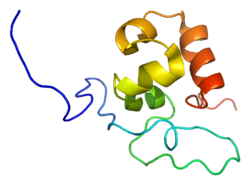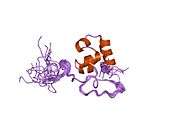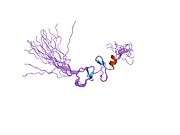ABLIM3
Actin-binding LIM protein 3 is a protein that in humans is encoded by the ABLIM3 gene.[5]
Function
The LIM domain is a double zinc finger structure that promotes protein-protein interactions. LIM domain proteins, such as ABLIM3, play roles in embryonic development, cell lineage determination, and cancer.[6] An important paralog of this gene is LIMS1.
Clinical relevance
Diseases associated with ABLIM3 include hepatoblastoma, and among its related super-pathways are axon guidance and DCC mediated attractive signaling.
gollark: Two Kaby Lake computers and a Zen 1 one.
gollark: I have a bunch of different things it could be tested on.
gollark: Oh, and about the lack of HTTP, backgrounds, that sort of thing (well, it's early alpha, so that makes sense). Still, it is definitely extremely cool.
gollark: Shame about the CC OS thing not being able to support teletext characters and whatnot. I wonder if there's a way to make it use a custom font.
gollark: And you can do better: `os.setComputerLabel(""..os.clock())`.
References
- GRCh38: Ensembl release 89: ENSG00000173210 - Ensembl, May 2017
- GRCm38: Ensembl release 89: ENSMUSG00000032735 - Ensembl, May 2017
- "Human PubMed Reference:". National Center for Biotechnology Information, U.S. National Library of Medicine.
- "Mouse PubMed Reference:". National Center for Biotechnology Information, U.S. National Library of Medicine.
- "Entrez Gene: ABLIM3 actin binding LIM protein family, member 3".
- Krupp M, Weinmann A, Galle PR, Teufel A (Jan 2006). "Actin binding LIM protein 3 (abLIM3)". International Journal of Molecular Medicine. 17 (1): 129–33. doi:10.3892/ijmm.17.1.129. PMID 16328021.
External links
- Human ABLIM3 genome location and ABLIM3 gene details page in the UCSC Genome Browser.
Further reading
- Maruyama K, Sugano S (Jan 1994). "Oligo-capping: a simple method to replace the cap structure of eukaryotic mRNAs with oligoribonucleotides". Gene. 138 (1–2): 171–4. doi:10.1016/0378-1119(94)90802-8. PMID 8125298.
- Suzuki Y, Yoshitomo-Nakagawa K, Maruyama K, Suyama A, Sugano S (Oct 1997). "Construction and characterization of a full length-enriched and a 5'-end-enriched cDNA library". Gene. 200 (1–2): 149–56. doi:10.1016/S0378-1119(97)00411-3. PMID 9373149.
- Nagase T, Ishikawa K, Suyama M, Kikuno R, Hirosawa M, Miyajima N, Tanaka A, Kotani H, Nomura N, Ohara O (Dec 1998). "Prediction of the coding sequences of unidentified human genes. XII. The complete sequences of 100 new cDNA clones from brain which code for large proteins in vitro". DNA Research. 5 (6): 355–64. doi:10.1093/dnares/5.6.355. PMID 10048485.
- Hartley JL, Temple GF, Brasch MA (Nov 2000). "DNA cloning using in vitro site-specific recombination". Genome Research. 10 (11): 1788–95. doi:10.1101/gr.143000. PMC 310948. PMID 11076863.
- Wiemann S, Weil B, Wellenreuther R, Gassenhuber J, Glassl S, Ansorge W, Böcher M, Blöcker H, Bauersachs S, Blum H, Lauber J, Düsterhöft A, Beyer A, Köhrer K, Strack N, Mewes HW, Ottenwälder B, Obermaier B, Tampe J, Heubner D, Wambutt R, Korn B, Klein M, Poustka A (Mar 2001). "Toward a catalog of human genes and proteins: sequencing and analysis of 500 novel complete protein coding human cDNAs". Genome Research. 11 (3): 422–35. doi:10.1101/gr.GR1547R. PMC 311072. PMID 11230166.
- Yamada S, Ohira M, Horie H, Ando K, Takayasu H, Suzuki Y, Sugano S, Hirata T, Goto T, Matsunaga T, Hiyama E, Hayashi Y, Ando H, Suita S, Kaneko M, Sasaki F, Hashizume K, Ohnuma N, Nakagawara A (Aug 2004). "Expression profiling and differential screening between hepatoblastomas and the corresponding normal livers: identification of high expression of the PLK1 oncogene as a poor-prognostic indicator of hepatoblastomas". Oncogene. 23 (35): 5901–5911. doi:10.1038/sj.onc.1207782. PMID 15221005.
- Zheng B, Wen JK, Han M, Zhou AR (Sep 2004). "hhLIM protein is involved in cardiac hypertrophy". Biochimica et Biophysica Acta (BBA) - Molecular Basis of Disease. 1690 (1): 1–10. doi:10.1016/j.bbadis.2004.04.009. PMID 15337165.
- Suzuki Y, Yamashita R, Shirota M, Sakakibara Y, Chiba J, Mizushima-Sugano J, Nakai K, Sugano S (Sep 2004). "Sequence comparison of human and mouse genes reveals a homologous block structure in the promoter regions". Genome Research. 14 (9): 1711–8. doi:10.1101/gr.2435604. PMC 515316. PMID 15342556.
- Wiemann S, Arlt D, Huber W, Wellenreuther R, Schleeger S, Mehrle A, Bechtel S, Sauermann M, Korf U, Pepperkok R, Sültmann H, Poustka A (Oct 2004). "From ORFeome to biology: a functional genomics pipeline". Genome Research. 14 (10B): 2136–44. doi:10.1101/gr.2576704. PMC 528930. PMID 15489336.
- Krupp M, Weinmann A, Galle PR, Teufel A (Jan 2006). "Actin binding LIM protein 3 (abLIM3)". International Journal of Molecular Medicine. 17 (1): 129–33. doi:10.3892/ijmm.17.1.129. PMID 16328021.
- Mehrle A, Rosenfelder H, Schupp I, del Val C, Arlt D, Hahne F, Bechtel S, Simpson J, Hofmann O, Hide W, Glatting KH, Huber W, Pepperkok R, Poustka A, Wiemann S (Jan 2006). "The LIFEdb database in 2006". Nucleic Acids Research. 34 (Database issue): D415–8. doi:10.1093/nar/gkj139. PMC 1347501. PMID 16381901.
- Olsen JV, Blagoev B, Gnad F, Macek B, Kumar C, Mortensen P, Mann M (Nov 2006). "Global, in vivo, and site-specific phosphorylation dynamics in signaling networks". Cell. 127 (3): 635–48. doi:10.1016/j.cell.2006.09.026. PMID 17081983.
- Barrientos T, Frank D, Kuwahara K, Bezprozvannaya S, Pipes GC, Bassel-Duby R, Richardson JA, Katus HA, Olson EN, Frey N (Mar 2007). "Two novel members of the ABLIM protein family, ABLIM-2 and -3, associate with STARS and directly bind F-actin". The Journal of Biological Chemistry. 282 (11): 8393–8403. doi:10.1074/jbc.M607549200. PMID 17194709.
This article is issued from Wikipedia. The text is licensed under Creative Commons - Attribution - Sharealike. Additional terms may apply for the media files.







